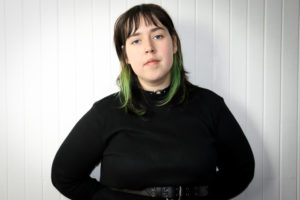Attuning to the Sonics of Revolt
Essay available in large font
Today I am exhausted. This week is my reading week, but I piled on a bunch of creative projects. I find myself resisting everything, as my body and mind scream for a break. I take a look at my to-do list and try to move around non-essentials. As a person with a disability, I am learning to listen and respect my needs with love and acceptance in a world that does not. As I wrestle with internalised ableism and fear, I find myself seeking stillness and quiet in an attempt to make the loudness of my overwhelm stop for a moment. I am fighting with myself again. Silence has always been a comfortable place for me. I have a hard time with loud noises. Libraries and art galleries, aside from the outdoors, are my favourite places. A deep absorptive quiet fills the space. I feel calmer.
In a noisy world with many loud narratives, attuning to the embodied hum of truth requires a certain kind of listening practice. Art, as a modality that engages with aesthetic expression, can be particularly well suited to such a practice. Working with affect, subtext, allusion, senses, embodiments and relationships, art is able to communicate across registers of expression. At once open to interpretation and grounded in material expression, art can allow us to listen and feel heard without necessarily demanding that we enunciate, narrate or categorise our experiences. Our most painful and traumatic experiences often evade language. We cannot find the words to make sense of the unimaginable, the unintelligible injustice of violence and suffering. The weight of despair can silence us, to the world around us and to ourselves. Art can allow us to be seen, to be heard, without having to arrive at fixed or linear conclusions. Art can be a capacious mode that can hold space for contradiction, paradox and the queerness of memory, despair and joy. Art can be a witness.
Silence itself can be a form of violence. We can think of the violence of genocidal erasure, of murder or death, as a form of silence. Archival erasures silence histories. The shame and fear of abuse, threat and oppression often make us bite our tongues. In interpersonal relationships, the silent treatment, gaslighting and abandonment weaponize silence. At a psychic level, we are unable to integrate traumatic loss, and the absence of memories, feelings or sensations can be unbearable.
Silence can also be a form of resistance. Under the weight of war, oppressive regimes, colonialism, homophobia and transphobia, abusive relationships, violent families, and all forms of social marginalisation, we find hope, joy, love and resilience amongst stealthier frequencies. Silence can be a form of refusal, a means of revolt. We make and unmake ourselves in the echoes.
The work of multidisciplinary artist Violet Drake tends to the queer paradoxes of these echoes through her exploration of trans*corporeal cartographies and the poetics of collage. Her triptych series Psyren offers a mesmerizing blend of self portraiture and digital painting that “begs us to reconcile with the ghosts of Newfoundland’s long and complicated histories for mad, queers, trans and sex working communities” (Violet Drake, Between Here and There: Artist Talks, February 19, 2021). Drake takes up hauntings as asymmetrical longings that both evade and persist. Working across the scales of psychic, historic and collective, Drake’s work with embodiment and archive tends to the interpersonal, somatic, archival and collective silences of this place. In doing so, Drake’s visual poetics inscribe the possibilities that silence cultivate, while simultaneously excavating the ways in which ableism, transphobia, rurality and anti-sex work occlude and oppress. In Drake’s work, silence is multivalent, multiscalar, multiplicand. Aesthetic encounters with visual art enable attunement to the queer frequencies of trauma, violence, resilience and joy that inflect social injustice. In doing so, art creates possibilities for change by imagining modes of expression, testimony and witness that do not foreclose complexity and tension and do not demand heterogeneous testimony. Listening against the frequencies of social injustice, visual art can invite us to attune to the sonics of revolt that hum in the silence.
 Kate Lahey is a writer, a Newfoundlander, front person of the band Weary, and PhD candidate at the Women and Gender Studies Institute, University of Toronto.
Kate Lahey is a writer, a Newfoundlander, front person of the band Weary, and PhD candidate at the Women and Gender Studies Institute, University of Toronto.
Photograph by Daniel Rumbolt
- aqua (2022) Mixed Media: Acrylic paint on canvas, Digital painting
- Violet Drake haema (2022) Mixed Media: Synthetic blood on canvas, Digital painting
- Violet Drake amnii (2022) Mixed Media: Acrylic paint on canvas, Digital painting






